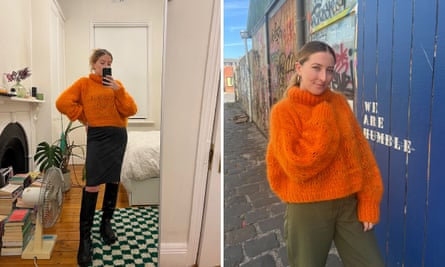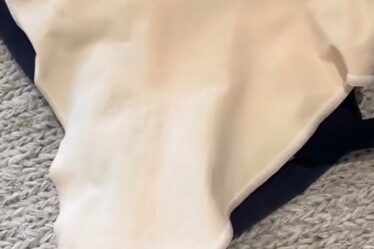
Although Marie Kondo recently admitted she had given up on tidying since having children, for many of us the appeal of a decluttered life and wardrobe endures.
Living with fewer clothes can be an adjustment. But with a bit of insider knowledge and skill, a capsule wardrobe (one made up of a few simple, coordinated pieces that can be worn daily on rotation) can be chosen to ensure you always have an appropriate outfit, no matter the occasion.
Just over a year ago, Melbourne brand Arnsdorf released an eight-piece capsule wardrobe consisting of two pairs of pants (one wide, the other tapered), a T-shirt, two singlets, a white shirt, a skirt and a blazer. Jade Sarita Arnott, the designer behind Arnsdorf, says the selection was about building the “strong fundamentals of a functional wardrobe” with “pieces that could be used in a variety of ways”.
Arnott’s intention is that customers will mix the capsule up with other items from their wardrobe, like vintage pieces, to “reflect their own personal style”. The garments were designed with a chameleon quality. Simple tweaks – such as swapping out sandals for heels, adding a scarf or changing handbags – can make each piece look casual or formal, feminine or androgynous, depending on the context in which it is worn.
Half the pieces are made in a wool suiting fabric, chosen because it wears well. “If you hang it up, it doesn’t really crease,” Arnott says. “It doesn’t need a lot of care. You don’t need to wash it very often – it’s sort of self-cleaning.
“I like the idea of a piece that will be worn over and over again, that you can just reach for without having to think too much about. I guess they’re the workhorse garments.”
Here we speak to two stylists and a fashion editor on the tweaks they use to style a small, workhorse wardrobe, while still keeping things interesting.
An experiment that stuck
Cait Burke, the editor of Fashion Journal, actually tried out the eight-piece capsule wardrobe from Arnsdorf during last year’s Melbourne fashion festival. For the colour devotee, the black and white selection was outside her comfort zone, but ultimately she found the experience liberating. “The getting ready process became so much more efficient,” she says. It forever changed the way she thinks about getting dressed. “[Now] I focus on an item’s comfort, fit and versatility much more.”
The hardest working items in her wardrobe are “unassuming”, “incredibly comfortable” and go with lots of different pieces. To build a capsule wardrobe, Burke suggests focusing on qualities like fabric breathability, stitching and fit to assess an item’s longevity.
Re-wearing pieces also highlights their practicality (or lack of it). “I forced myself to get rid of tops that were just too annoying to wear,” she says. Items with “multiple ties that often came undone, didn’t properly accommodate my larger bust or were made of cheap synthetics that clung on to the smell of sweat and perfume” were all pruned out.
Although her experiment relied mainly on black pieces, Burke says getting dressed with less needn’t be drab. “My bright orange Frisson Knits jumper is a great example of this – it’s bold in both its shape and colour, but it works with my other core pieces … I wear it constantly.”
Mix it up
Photographer and stylist Gadir Rajab suggests picking a palette and sticking with it. “If you generally migrate towards neutrals or blacks then make sure your core pieces are in those colours.”
Next, make sure there is some variation of shapes, cuts and fabrics within each category: pants, jackets, tops, etc. “Mix it up with denim and cargos for bottoms,” he says, and make sure you have woollen knits, cotton jersey options, a leather bomber jacket and a denim jacket, so you can dress things up or down.
after newsletter promotion

He advocates for building variety into your looks by layering, like wearing a hoodie under a jacket or coat. Shirts are equally versatile, because they can be worn open over T-shirts and tanks, or buttoned up closed. “A bomber jacket will always be timeless layered with an open shirt.”
To bring more personality to a minimal wardrobe he uses accessories. “If you’re wearing a plain tee and cargo pants without a cap or cool sneakers it could be super boring.” His other suggestions for adding excitement include silver and gold chains, or clipping a carabiner hook and keys to the belt loop of your pants. Or, if you really want to dress it up, take a page from Timothée Chalamet’s lookbook and cinch a shirt beneath a corset.

A library of fabrics
Caroline Tran agrees that sticking to a colour palette is important, and that for longevity and styling, neutral tones such as black, white, beiges and creams “work best”. But the stylist says you can still include pops of colour, so long as they work well with your neutral tones. “This can range from plum to pink to bright green.”
Quality is key. “Well cut trousers, shirts, T-shirts, blazers, a day dress” can all be transitioned from casual to business and to dressier events, she says. And as long as the fabric and cut is interesting, the same style can work during the day or at night. She says a well cut tank top can be worn with jeans in the day then dressed up with more formal trousers, for instance.
She suggests thinking of your capsule wardrobe as “a library of fabrics and weights, that also can be easily layered”, so it doesn’t feel too utilitarian, or work focused.



